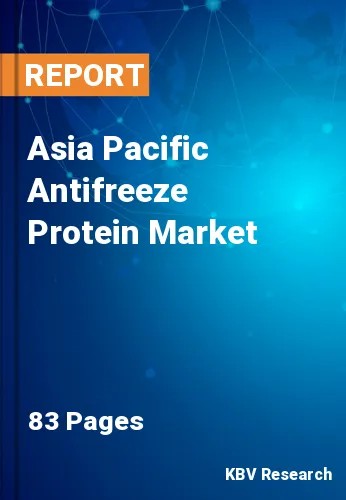The Asia Pacific Antifreeze Protein Market would witness market growth of 26.2% CAGR during the forecast period (2022-2028).
AFPs can be classified based on two characteristics: TH and IRI. However, the possibility of AFPs interacting with membranes should not be discounted. The gap between a solution's melting and freezing points is referred to as TH. The temperature gap can be established in an AFP-containing solution by irreversible AFP binding to ice crystals and subsequent suppression of the growth until the temperature drops to the non-equilibrium freezing point. The ice crystal explosion can be seen below the non-equilibrium freezing point. AFPs bind to specific planes of ice crystals during the TH gap, forming a distinct ice morphology. Type I AFPs, for example, attach to ice's prism plane and produce a hexagonal bipyramidal structure, whereas hyperactive FfIBP binds to the prism and basal planes and produces a lemon shape.
Moderately active AFPs bind to the prism and/or pyramidal planes of ice crystals, whereas hyperactive AFPs can bind to the basal plane. The AFP-shaped ice morphology is a characteristic of AFP-ice binding. TH has been utilized to quantitatively describe the activity of AFPs. The observed TH activity for most fish AFPs is around 1 °C. During the winter season (1.9 °C), this temperature gap provides enough insulation against seawater for polar fish to survive in frigid surroundings. Many marine AFPs are linked to sea ice, in complement to fish AFPs. Seawater in brine channels in sea ice, unlike the blood plasma of polar fish, freezes to ice.
The medical technology companies of the region are making an extensive investment in research & development of methods of preserving biological samples. The winter leaves of Ammopiptanthus mongolicus, an evergreen legume species that survive in the freezing deserts of northwest China, were refined to produce a boiling-soluble antifreeze protein (AFP). Purification was accomplished using a procedure that included a heat treatment step followed by chromatography, which included ion-exchange chromatography, molecular exclusion chromatography with Sephacryl S300, and hydrophobic interaction chromatography with Sephacryl S300. This AFP exhibited thermal hysteresis activity and has the ability to alter ice crystal formation. It is revealed that this isolated antifreeze protein has a thermal hysteresis activity (THA) of 0.15°C at a concentration of 10 mg/mL and a molecular mass of 28 kD.
The evolutionary history of the AFP families may be traced back to almost many million years ago when the sea level in Antarctica began to freeze; nevertheless, the degree of expression of ice-binding proteins varies between species. The scientists discovered that non-coding DNA fragments were the source of the gene families that code for distinct types of AFPs.
The China market dominated the Asia Pacific Antifreeze Protein Market by Country 2021, and would continue to be a dominant market till 2028; thereby, achieving a market value of $3,030.9 Thousands by 2028. The Japan market is experiencing a CAGR of 25.4% during (2022 - 2028). Additionally, The India market would exhibit a CAGR of 26.9% during (2022 - 2028).
Based on Type, the market is segmented into Type I, Type III, Antifreeze Glycoprotein, and Others. Based on Form, the market is segmented into Solid and Liquid. Based on Source, the market is segmented into Fish and Others. Based on End-use, the market is segmented into Medical, Food, Cosmetics, and Others. Based on countries, the market is segmented into China, Japan, India, South Korea, Singapore, Malaysia, and Rest of Asia Pacific.
Free Valuable Insights: The Worldwide Antifreeze Protein Market is Projected to reach USD 29 Million by 2028, at a CAGR of 25.7%
The market research report covers the analysis of key stake holders of the market. Key companies profiled in the report include Kaneka Corporation, Unilever PLC, Nichirei Corporation, A/F Protein Canada Inc., Sirona Biochem, Protokinetix, Inc., Shanghai Yu Tao Industrial Co., Ltd., Kodera herb garden co., ltd., Rishon Biochem Co., Ltd., and Mybiosource, Inc.
By Type
By Form
By Source
By End Use
By Country
Our team of dedicated experts can provide you with attractive expansion opportunities for your business.

